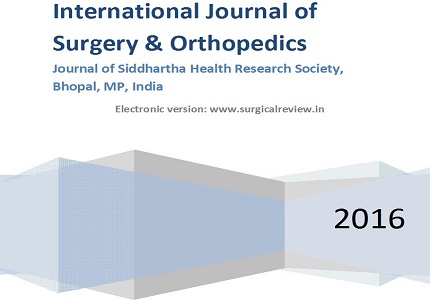Retrospective observational study of performance in outcome of emergency appendicectomy
Abstract
Objective: The present study is aimed to investigate variations in outcome of Emergency Appendectomy being conducted in Surgery Unit- II at ESIC Medical College, Joka, Diamond Harbour Road, Kolkata, West Bengal. The main outcome interest was the normal Histopathology rate, secondary outcomes and thirty (30) days adverse events rate with varied parameters like different timings of operation, presence or absence of consultant etc.
Method: The study was performed in Surgery UNIT II in ESIC Medical College, Joka, Kolkata, and West Bengal. The trainee level Investigator was responsible for identifying patients, entering DATA in the prespecified database and ensuing completeness of data. Patients undergoing appendectomy for suspected Acute Appendicitis between Aug 2015 to Aug 2016 inclusive of all age & sex are included in this study. The study was approved by the Institutional ethical committee. The post operative complications were followed for 30 days after surgical appendectomy during day time, evening hours and night time and compared in terms of percentage of evidence.
Results: A total number of fifty (50) Emergency appedidectomy cases were studied by open surgery. Histologically Normal appendix was removed in 10 numbers of cases i.e. 20%.It was observed that the outcome percentage of daytime operation with requisite duration and by specialist consultant is far better than that of night time or evening time operation by senior trainee . It was also observed that adverse effects after 30days post operative period were significantly reduced in case of day time operation.
Conclusions: This study reveals the wide variations in practice patterns and outcome which should be addressed to improve performance.. The surgical procedure done in day time by expertise consultant can effectively reduce the adverse post operative complications.
Downloads
References
2. Fine LG, Keogh BE, Cretin S et al.,Cardiac surgery Experience: How to evaluate and improve the quality and credibility of an outcome database-Validation and feedback studyon UK,BMJ,326,25-28.
3. Alder AC, Fomby TB, Woodward WA, Haley RW, Sarosi G, Livingston EH. Association of viral infection and appendicitis.Arch Surg. 2010 Jan;145(1):63-71. doi: 10.1001/archsurg.2009.250.
4. Ignacio RC, Burke R, Spencer D, Bissell C, Dorsainvil C, Lucha PA. Laparoscopic versus open appendectomy: what is the real difference? Results of a prospective randomized double-blinded trial. Surg Endosc. 2004 Feb;18(2):334-7. Epub 2003 Dec 29.
5. Patterson HM, QadanM,delaca SM, Nixon SJ, Patterson- BrownS, Changing trends in surgery for acute appendicitis Br J Surg,2008,95:303-308. [PubMed]
6. Güller U, Rosella L, McCall J, Brügger LE, Candinas D. Negative appendicectomy and perforation rates in patients undergoing laparoscopic surgery for suspected appendicitis. Br J Surg. 2011 Apr;98(4):589-95. doi: 10.1002/bjs.7395. Epub 2011 Jan 24. [PubMed]
7. Teixeira PG, Sivrikoz E, Inaba K, Talving P, Lam L, Demetriades D. Appendectomy timing: waiting until the next morning increases the risk of surgical site infections. Ann Surg. 2012 Sep;256(3):538-43. doi: 10.1097/SLA.0b013e318265ea13. [PubMed]
8. Cuscheri J, Florence M,Flum DR . JurkovichGJ, LInp,SrelleSR et al,Negativeappendidectomy and Imaging accuracy in the Washington State surgical care and outcome assessment programme.Ann. surg.,2008,248:557-558. [PubMed]
9. Lee CC, Golub R, Singer AJ, Cantu R Jr, Levinson H. Routine versus selective abdominal computed tomography scan in the evaluation of right lower quadrant pain: a randomized controlled trial. Acad Emerg Med. 2007 Feb;14(2):117-22. Epub 2006 Dec 27.
10. Sicard N, Toussignant P, Pineault R, Dube S, Non patient factors related to rates of ruptured appendicitis, Br. J Surg,2007,94,214-21.

Copyright (c) 2016 Author (s). Published by Siddharth Health Research and Social Welfare Society

This work is licensed under a Creative Commons Attribution 4.0 International License.


 OAI - Open Archives Initiative
OAI - Open Archives Initiative


















 Therapoid
Therapoid

